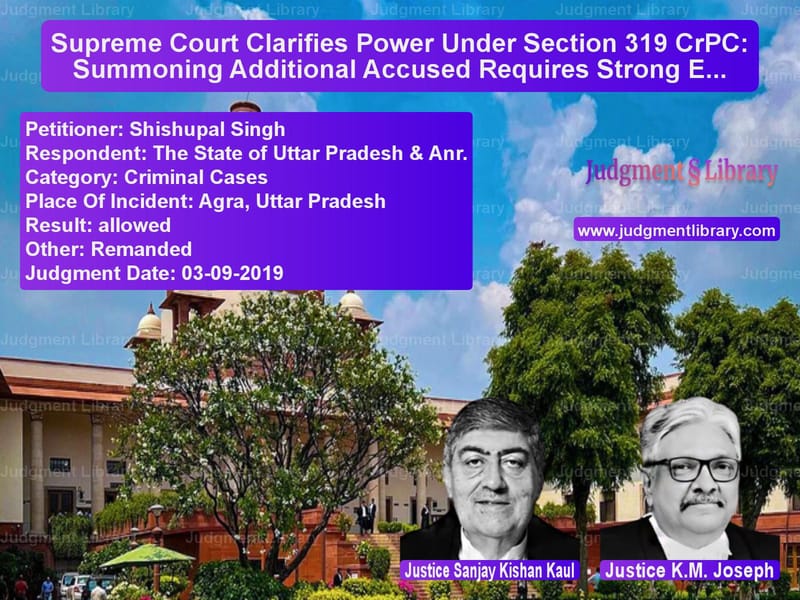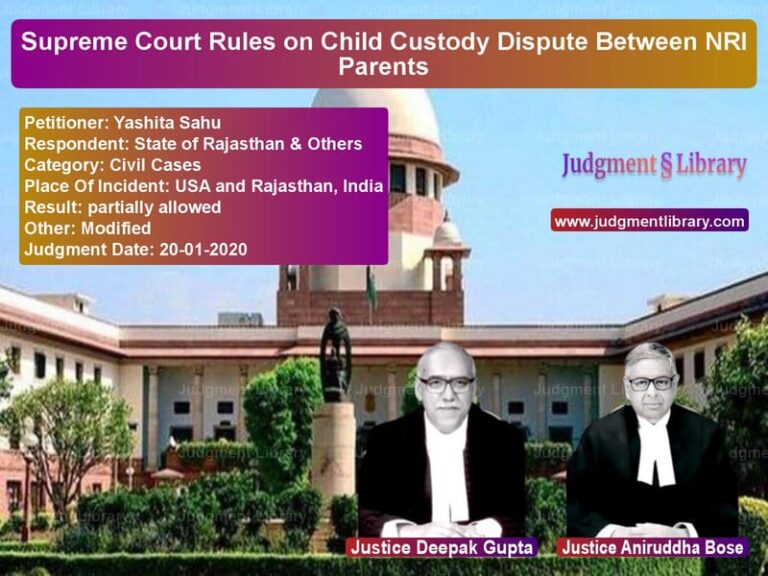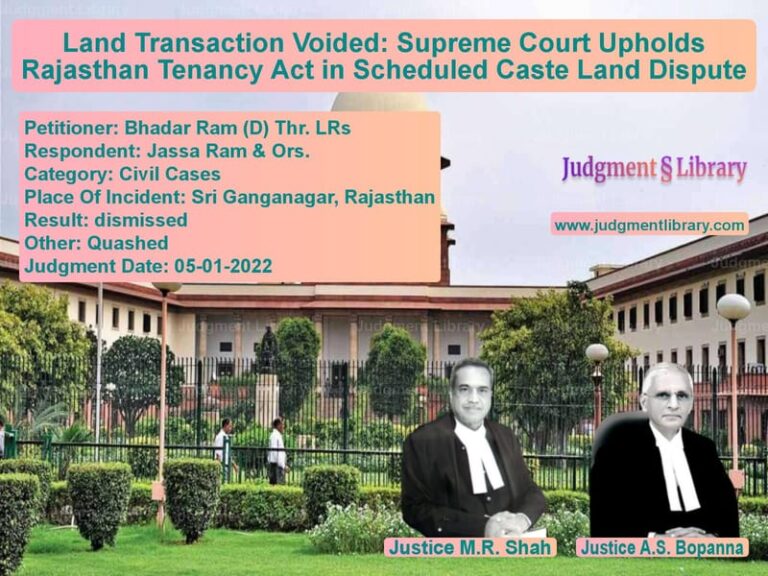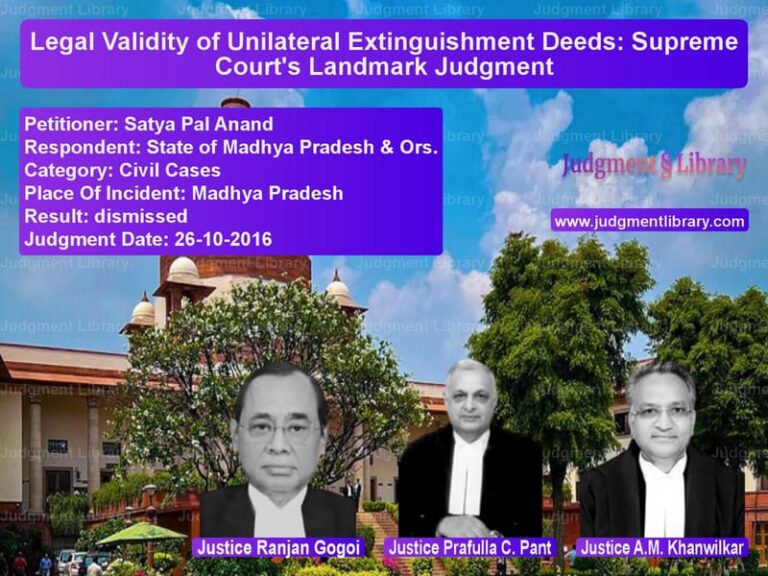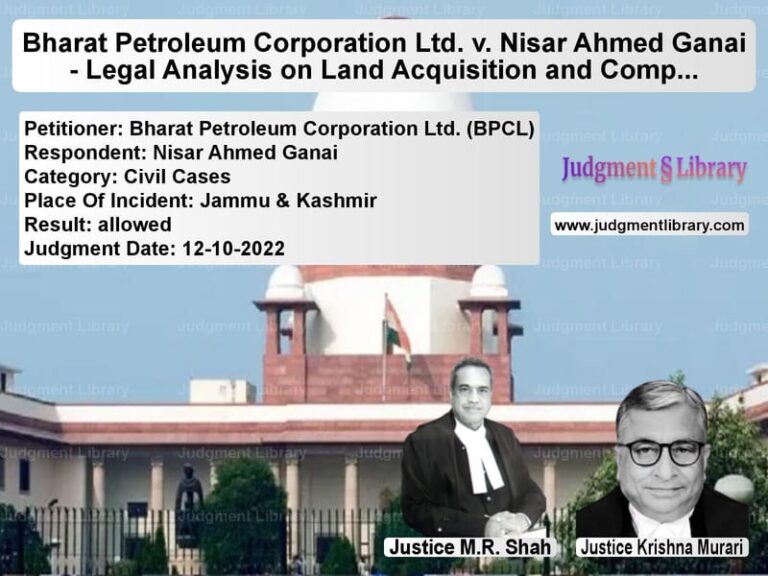Supreme Court Clarifies Power Under Section 319 CrPC: Summoning Additional Accused Requires Strong Evidence
The case of Shishupal Singh v. The State of Uttar Pradesh & Anr. revolved around the summoning of an additional accused under Section 319 of the Criminal Procedure Code (CrPC). The Supreme Court examined whether the trial court and High Court correctly applied the legal principles for invoking Section 319.
The judgment reinforced that summoning an individual under Section 319 CrPC requires strong and cogent evidence and should not be exercised in a casual manner. The Court ultimately set aside the orders of the lower courts, emphasizing that a prima facie case must be based on substantive evidence presented during the trial.
Background and Key Issues
The case stemmed from an FIR registered on September 4, 2005, in P.S. Khera Garh, District Agra, Uttar Pradesh, for offenses under Sections 147, 148, 149, 307, 302, 323, 504, and 506 of the Indian Penal Code (IPC). The police conducted an investigation and filed a charge sheet against the accused.
During the trial, based on the examination-in-chief of the complainant (PW-1), the trial court exercised its power under Section 319 CrPC to summon Shishupal Singh as an additional accused. The appellant challenged this order in revision, which was dismissed by the High Court. Consequently, the appellant filed an appeal before the Supreme Court.
The key legal questions before the Supreme Court were:
- Was the summoning of the appellant under Section 319 CrPC justified based on the evidence on record?
- Did the lower courts correctly apply the principles laid down in prior Supreme Court judgments?
- What degree of evidence is required to summon an individual under Section 319 CrPC?
Arguments of the Petitioner (Shishupal Singh)
The appellant made the following arguments:
- His name was included in the FIR, but no charge sheet was filed against him after the police investigation.
- The complainant (PW-1) was the only witness who named him, while other eyewitnesses, including the injured witness, did not mention his involvement.
- The trial court incorrectly recorded that the prosecution had moved an application under Section 319 CrPC, whereas the complainant had actually filed the application.
- The trial court erroneously stated that the appellant had fired upon the victims, which was not part of the original complaint or witness testimony.
- The High Court did not adequately examine whether the trial court had applied the correct legal principles while invoking Section 319 CrPC.
Arguments of the Respondent (State of Uttar Pradesh)
The State contended:
- Section 319 CrPC allows the trial court to summon any person who was not named in the charge sheet if evidence presented in court shows their involvement in the offense.
- The complainant’s testimony (PW-1) was sufficient to invoke Section 319 CrPC.
- The High Court correctly held that the trial court was within its rights to summon the appellant based on the material on record.
Supreme Court’s Key Observations
The Supreme Court extensively examined the principles governing the invocation of Section 319 CrPC. The Court referred to its previous rulings, particularly Hardeep Singh v. State of Punjab & Ors. (2014) and Brijendra Singh & Others v. State of Rajasthan (2017), and reiterated the following:
“Power under Section 319 CrPC can be exercised by the trial court at any stage before the conclusion of the trial to summon any person as an accused if there is evidence indicating their guilt. However, the power must be exercised sparingly and only in cases where strong and cogent evidence exists.”
1. Strength of Evidence Required for Section 319 CrPC
The Court emphasized that the degree of satisfaction required under Section 319 CrPC is higher than that required for framing charges under Section 227 or 228 CrPC. It must be based on:
- Material brought before the court during the trial.
- Substantial evidence that indicates the involvement of the person in the crime.
- Not mere probability but a strong prima facie case.
2. Errors in the Trial Court’s Findings
The Supreme Court noted that the trial court had misinterpreted the complainant’s testimony. The Court found:
“The role ascribed to the appellant is also not correctly reflected as it has been stated that he fired upon them with an intention to kill them. This is not what was stated in the complaint nor is it part of the testimony recorded of PW-1.”
3. Incorrect Legal Reasoning by the High Court
The Supreme Court criticized the High Court for failing to assess whether the trial court had properly applied the legal principles before invoking Section 319 CrPC. The Court held:
“The controversy generated was not whether power could or could not be exercised under Section 319 CrPC but whether the exercise, which was required to be undertaken by the trial Court before exercising such power, had been completed or not.”
Final Judgment
The Supreme Court set aside the orders of the trial court and the High Court, ruling that:
- The invocation of Section 319 CrPC in this case was improper.
- The trial court had not correctly applied the legal principles while summoning the appellant.
- The matter was remanded to the trial court to reconsider the application under Section 319 CrPC based on proper legal standards.
Impact of the Judgment
The Supreme Court’s ruling provides important guidance on the use of Section 319 CrPC:
- Higher Standard of Evidence: Trial courts must ensure that evidence is strong and reliable before summoning additional accused.
- Preventing Arbitrary Summons: The ruling prevents misuse of Section 319 CrPC, ensuring that innocent persons are not dragged into criminal trials without strong justification.
- Clear Guidelines for Lower Courts: Courts must carefully assess whether the evidence meets the necessary legal standard before summoning additional accused.
- Ensuring Fair Trials: The decision reinforces that judicial discretion must be exercised with caution to protect the rights of individuals.
The Supreme Court’s decision serves as a significant precedent in ensuring that Section 319 CrPC is applied fairly and only in cases where there is compelling evidence of an individual’s involvement in a crime.
Petitioner Name: Shishupal Singh.Respondent Name: The State of Uttar Pradesh & Anr..Judgment By: Justice Sanjay Kishan Kaul, Justice K.M. Joseph.Place Of Incident: Agra, Uttar Pradesh.Judgment Date: 03-09-2019.
Don’t miss out on the full details! Download the complete judgment in PDF format below and gain valuable insights instantly!
Download Judgment: Shishupal Singh vs The State of Uttar P Supreme Court of India Judgment Dated 03-09-2019.pdf
Direct Downlaod Judgment: Direct downlaod this Judgment
See all petitions in Bail and Anticipatory Bail
See all petitions in Attempt to Murder Cases
See all petitions in Judgment by Sanjay Kishan Kaul
See all petitions in Judgment by K.M. Joseph
See all petitions in allowed
See all petitions in Remanded
See all petitions in supreme court of India judgments September 2019
See all petitions in 2019 judgments
See all posts in Criminal Cases Category
See all allowed petitions in Criminal Cases Category
See all Dismissed petitions in Criminal Cases Category
See all partially allowed petitions in Criminal Cases Category

